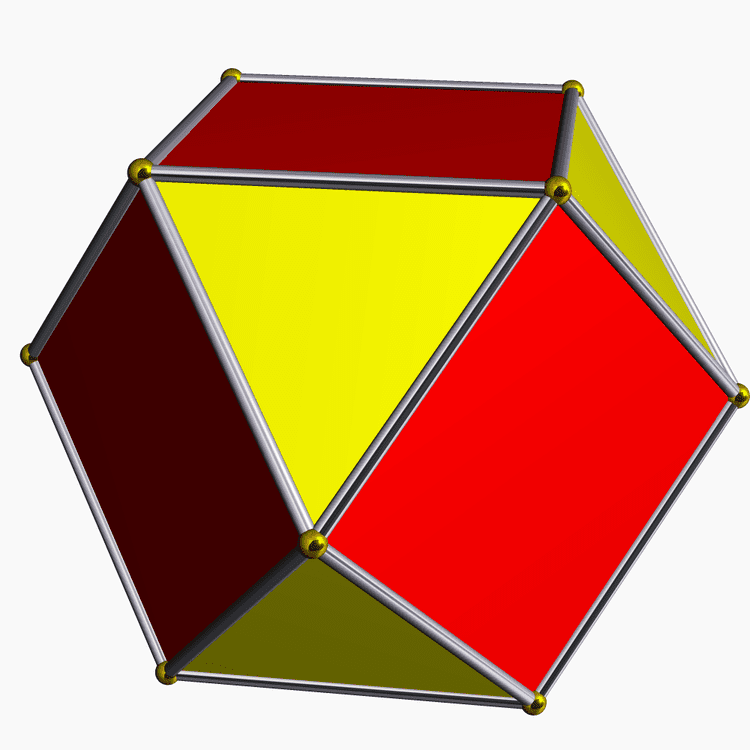 | ||
In Euclidean geometry, rectification or complete-truncation is the process of truncating a polytope by marking the midpoints of all its edges, and cutting off its vertices at those points. The resulting polytope will be bounded by vertex figure facets and the rectified facets of the original polytope. A rectification operator is sometimes denoted by the symbol r: for example, r{4,3} is the rectified cube, namely the cuboctahedron.
Contents
- Example of rectification as a final truncation to an edge
- Higher degree rectifications
- Example of birectification as a final truncation to a face
- In polygons
- In polyhedra and plane tilings
- In nonregular polyhedra
- In 4 polytopes and 3d honeycomb tessellations
- Degrees of rectification
- Notations and facets
- Regular polygons
- Regular polyhedra and tilings
- Regular Uniform 4 polytopes and honeycombs
- Regular 5 polytopes and 4 space honeycombs
- References
Conway polyhedron notation uses ambo for this operator. In graph theory this operation creates a medial graph.
Example of rectification as a final truncation to an edge
Rectification is the final point of a truncation process. For example, on a cube this sequence shows four steps of a continuum of truncations between the regular and rectified form:
Higher degree rectifications
Higher degree rectification can be performed on higher-dimensional regular polytopes. The highest degree of rectification creates the dual polytope. A rectification truncates edges to points. A birectification truncates faces to points. A trirectification truncates cells to points, and so on.
Example of birectification as a final truncation to a face
This sequence shows a birectified cube as the final sequence from a cube to the dual where the original faces are truncated down to a single point:
In polygons
The dual of a polygon is the same as its rectified form. New vertices are placed at the center of the edges of the original polygon.
In polyhedra and plane tilings
Each platonic solid and its dual have the same rectified polyhedron. (This is not true of polytopes in higher dimensions.)
The rectified polyhedron turns out to be expressible as the intersection of the original platonic solid with an appropriated scaled concentric version of its dual. For this reason, its name is a combination of the names of the original and the dual:
- The rectified tetrahedron, whose dual is the tetrahedron, is the tetratetrahedron, better known as the octahedron.
- The rectified octahedron, whose dual is the cube, is the cuboctahedron.
- The rectified icosahedron, whose dual is the dodecahedron, is the icosidodecahedron.
- A rectified square tiling is a square tiling.
- A rectified triangular tiling or hexagonal tiling is a trihexagonal tiling.
Examples
In nonregular polyhedra
If a polyhedron is not regular, the edge midpoints surrounding a vertex may not be coplanar. However, a form of rectification is still possible in this case: every polyhedron has a polyhedral graph as its 1-skeleton, and from that graph one may form the medial graph by placing a vertex at each edge midpoint of the original graph, and connecting two of these new vertices by an edge whenever they belong to consecutive edges along a common face. The resulting medial graph remains polyhedral, so by Steinitz's theorem it can be represented as a polyhedron.
The Conway polyhedron notation equivalent to rectification is ambo, represented by a. Applying twice aa, (rectifying a rectification) is Conway's expand operation, e, which is the same as Johnson's cantellation operation, t0,2 generated from regular polyhedral and tilings.
In 4-polytopes and 3d honeycomb tessellations
Each Convex regular 4-polytope has a rectified form as a uniform 4-polytope.
A regular 4-polytope {p,q,r} has cells {p,q}. Its rectification will have two cell types, a rectified {p,q} polyhedron left from the original cells and {q,r} polyhedron as new cells formed by each truncated vertex.
A rectified {p,q,r} is not the same as a rectified {r,q,p}, however. A further truncation, called bitruncation, is symmetric between a 4-polytope and its dual. See Uniform 4-polytope#Geometric derivations.
Examples
Degrees of rectification
A first rectification truncates edges down to points. If a polytope is regular, this form is represented by an extended Schläfli symbol notation t1{p,q,...} or r{p,q,...}.
A second rectification, or birectification, truncates faces down to points. If regular it has notation t2{p,q,...} or 2r{p,q,...}. For polyhedra, a birectification creates a dual polyhedron.
Higher degree rectifications can be constructed for higher dimensional polytopes. In general an n-rectification truncates n-faces to points.
If an n-polytope is (n-1)-rectified, its facets are reduced to points and the polytope becomes its dual.
Notations and facets
There are different equivalent notations for each degree of rectification. These tables show the names by dimension and the two type of facets for each.
Regular polygons
Facets are edges, represented as {2}.
Regular polyhedra and tilings
Facets are regular polygons.
Regular Uniform 4-polytopes and honeycombs
Facets are regular or rectified polyhedra.
Regular 5-polytopes and 4-space honeycombs
Facets are regular or rectified 4-polytopes.
